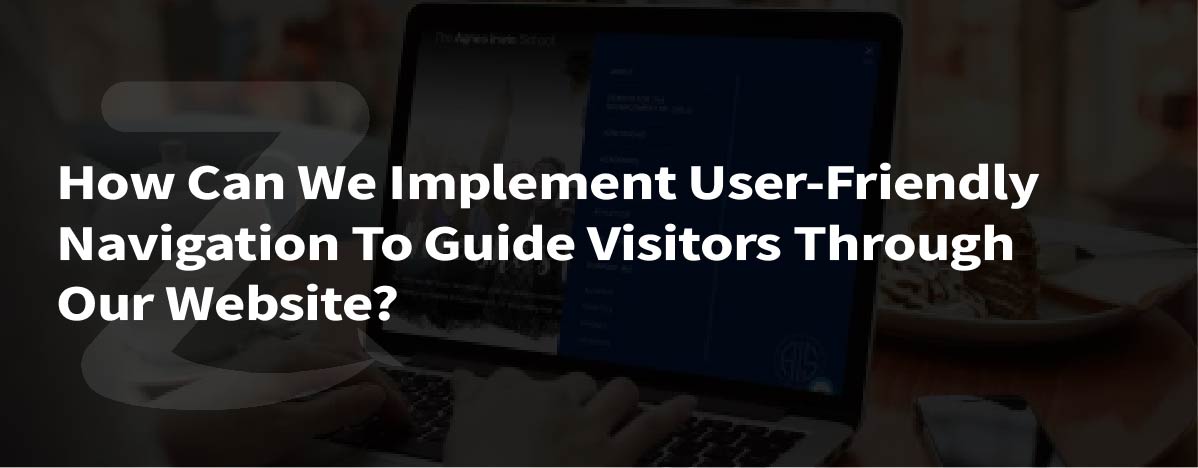How Can We Implement User-Friendly Navigation To Guide Visitors Through Our Website?
Creating user-friendly navigation ensures website menus and buttons are easy for everyone to click and explore without any confusion.
Content-
- What is Navigation in a Website?
- What is User-Friendly Navigation?
- What is the Purpose of Navigation on a Website?
- What is the Function of Navigation of a Website?
- How to Structure Your Website for Easy User-Friendly Navigation?
- How can we Implement User-Friendly Navigation to Guide Visitors through our Website?
What Is Navigation In A Website?
The art of website navigation highlights the significance and relevance of websites, content, and data. It serves as a reference point for users and visitors, facilitating their search for the needed content on a website. It encompasses various presentation techniques, including header or footer menus, spider bars, and more. The simplicity and usability of a website's navigation are crucial factors in its success.
What Is User-Friendly Navigation?
User-friendly navigation refers to a website or web page design and structure that ensures a seamless and straightforward user experience during their visit. It comprises several key elements, including:
- Ease of Access: User-friendly navigation allows users to quickly find the features or information they need without unnecessary complexity or confusion.
- Easy Usability: It ensures that the website's features are simple to use and intuitive, reducing any friction during the user journey.
- Strong Architecture: At the heart of user-friendliness is a well-structured and organized navigation system, which enables users to traverse the website logically and effectively.
- Consistency: User-friendly navigation maintains the website's appearance and layout consistently, making it easier for visitors to understand and anticipate how to navigate.
- Subject and Headings: Clear headers and subheadings help users grasp the text hierarchy and locate relevant information.
- Adaptation to User Needs: An effective navigation system caters to users' demands by providing relevant options and guiding them to the information or actions they seek.
- Orientation: It offers visual cues to indicate the user's position within the website and provides easy back- and forward-navigation options.
- Search Functionality: Including a search option makes it easier for users to find specific products or content, enhancing navigation.
User-friendly navigation is a fundamental aspect of web design, prioritizing user convenience and enabling easy exploration and engagement with a website or web page.
What Is The Purpose Of Navigation On A Website?
The navigation on a website serves multiple purposes.
It acts as a compass that guides users across a webpage, ensuring they can easily find significant points of interest and navigate seamlessly deeper into the site. Its primary objective is to enhance user engagement by creating a welcoming online environment that captivates users' interests and encourages exploration.
What Is The Function Of Navigation Of A Website?
The navigation of a website performs several vital tasks:
- Enhancing Usability and User Experience: Navigation boosts a website's overall usability by providing clear pathways and easy access to content and services, significantly improving the user experience.
- Enabling Frictionless Interactions: Navigation tools are essential for delivering a seamless user experience, ensuring that interactions on the website are smooth and free from issues.
- Efficiency and Convenience: Website navigation maximizes efficiency by streamlining the user's path and reducing the time and effort required to discover specific content or carry out desired actions.
- Mapping Key Areas: Navigation serves as a dynamic map of a website's key sections and features, similar to a map of a place rich with attractions.
Website navigation serves both a purpose and a function, with the overall aim being to create an engaging, user-friendly digital environment that promotes exploration and enhances user satisfaction.
How To Structure Your Website For Easy User-Friendly Navigation?
- Different Strategies: The setup of your website will depend on the context. Common approaches include:
- Task-Based: Organize content according to the specific tasks or operations users wish to perform.
- Content-Based: Organize content by type or subject matter.
- Menu-Driven: Utilize menus for effortless navigation.
- Transactional: A framework for online purchases or transactions.
- Make Hypertext Clear and Unique: Ensure your hypertext is distinctive and clear to stand out from other page elements, typically appearing as blue underlined text.
- Highlight Key Links: To make primary header navigation links more prominent, consider making them buttons.
- Streamline and Personalise the Navigation Bar: If the menu becomes lengthy, organize it based on content needs. Place categorized links in layered menus.
- Use Footers and Separate Sidebars: Keep sidebars distinct and noticeable, possibly using different colors. Footers can help organize content and reduce clutter.
- Reserve Buttons for Important Actions You Want Users to Take: Use buttons for Calls to Action and ensure they stand out on the page without creating a crowded look.
The success of your website hinges on having easy-to-use navigation and accessible content. Strive to make your website user-friendly and engaging for visitors.
How Can We Implement User-Friendly Navigation To Guide Visitors Through Our Website?
We can implement user-friendly navigation to guide visitors through our website by using practical reasoning when positioning menus. Place them prominently on the website, such as at the top or side, where users expect to find them.
- Include Graphical Components: Enhance the visibility of links and options by incorporating graphical elements into the navigation, such as buttons or icons.
- Links That Can Be Seen: Ensure links are clearly visible by using contrasting colors and fonts to make them stand out.
- Logical Link Order: Organize links logically and cohesively, with a hierarchy reflecting the importance and relevance of each page or element.
- Footer Navigation: Provide users with alternative access points through a footer that contains all necessary links, serving as a secondary navigation option.
- Responsive Design: Utilize responsive design to ensure optimal usability and user experience across all platforms (desktop, mobile, and tablet).
- Avoid Hidden Menus: Users may become frustrated if essential navigation options are concealed behind complicated or hidden menus.
- Descriptive Link Titles: Employ concise, descriptive link titles that clearly convey what information or function they represent, reducing the chance for user misunderstanding.
By adopting these website navigation strategies, you can create an intuitive browsing experience that enables users to explore your website effortlessly and naturally.

























































